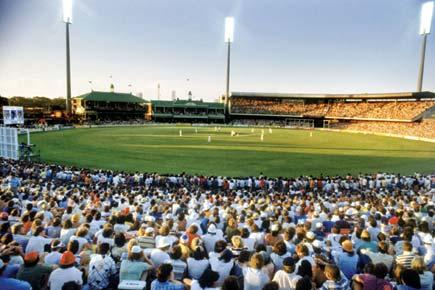To the current Australian and New Zealand cricket teams, tomorrow, November 27, 2015, will be remembered as a special day in their careers — the day the lights came on in Test cricket

 To the current Australian and New Zealand cricket teams, tomorrow, November 27, 2015, will be remembered as a special day in their careers — the day the lights came on in Test cricket. And for all who congregate at the Adelaide Oval to watch cricket’s first day-night Test, it will be an experience of a lifetime.
To the current Australian and New Zealand cricket teams, tomorrow, November 27, 2015, will be remembered as a special day in their careers — the day the lights came on in Test cricket. And for all who congregate at the Adelaide Oval to watch cricket’s first day-night Test, it will be an experience of a lifetime.
ADVERTISEMENT
There won’t be a pink ball revolution so soon. Neither can we predict if day/night Test cricket will be a hit, but a start has been made to give Test cricket a chance to attract more interest in the stands.
 A record crowd of 50,000 at the Sydney Cricket Ground enjoy the Australia vs West Indies International Cup action on November 28, 1978. Australia won this World Series Cricket encounter by five wickets. Pic/Getty Images
A record crowd of 50,000 at the Sydney Cricket Ground enjoy the Australia vs West Indies International Cup action on November 28, 1978. Australia won this World Series Cricket encounter by five wickets. Pic/Getty Images
Cricket under lights did wonders for viewership all over the world and Kerry Packer’s World Series Cricket must take the credit for this. Before November 28, 1978, day/night World Series Cricket games were played on non-cricket grounds. And on that afternoon, the spectators outside the main gates of the Sydney Cricket Ground (SCG) were so huge in number that Packer instructed the personnel at the gates to let the crowd in before the scheduled time of opening. He didn’t want a situation where the spectators were outside while the first ball was being bowled.
A little more than a year before that day, there were only 500 spectators for the start of the Packer series at Football Park in Adelaide and at one point in time, Packer and his assistants would actually count how many spectators were heading to their cricket circus. Later, floodlights improved the numbers through the gates but Packer was never given traditional cricket grounds for his games.
However, in 1978, the government of New South Wales replaced the trust that ran the SCG with another one, which erected floodlights at Australia’s second ‘senior-most’ Test venue. Packer grabbed the opportunity and thus WSC Australia took on WSC West Indies in their International Cup opener at the SCG with 50,000-plus crowds in anticipation of the lights. The players were no less excited. Michael Holding looked outside the dressing room and noticed a packed house and even a slow-to-emotion man like Ian Chappell felt his hair standing when the crowds sang C’mon Aussie, C’mon. To play under lights at a Test ground seemed so very special.
The noise at the ground was such that the late David Hookes couldn’t hear his partner Ian Davis and Hookes was run out for three while chasing a 129-run target set by Clive Lloyd’s West Indians. Opener Bruce Laird was run out as well, but Davis (48 not out) guided them to a five-wicket win. In the DVD Rookies, Rebels and Renaissance, Ian Chappell revealed what was said after the game: “Rodney Marsh said, we’re bloody back. They (cricket followers) love us and the indication of Rodney’s words was, we have been accepted. That was the moment, we felt, we were accepted as ‘the’ Australian team. We were ‘the’ Australian team that night at the SCG.” Marsh revealed that players who were not even in the playing XI had tears in their eyes.
Chappell, now a television commentator, will witness a historic moment tomorrow, just as he did on November 28, 1978, but sadly Richie Benaud, who played a big role in the Packer series is not around for the day/night Test. He was a traditionalist but always welcomed changes that were going to have a beneficial influence on the game.
After that hugely appreciated match, Benaud and his wife Daphne raised their glass of wine to Packer and said nothing. The crowds had said it all.
It must be stressed that Benaud played a leading hand in the revival of Test cricket in Australia during the 1960-61 summer when he and his opposing captain Sir Frank Worrell encouraged positive cricket to prevail in the Australia vs West Indies five-Test contest. On the eve of the opening Test of that series, Sir Donald Bradman asked Benaud whether he could talk to his team. Benaud agreed, but stressed to the legend that he would first have to ask his team. And when they expectedly agreed, Bradman came in and urged them to play in a fashion that would entertain the public. What emerged first up from that ‘licence to thrill’ was the Brisbane Tied Test, and the rest is history.
New Zealand’s skipper Brendon McCullum and his rival captain Steve Smith have something to emulate. If flair and positive cricket flow in tomorrow’s Adelaide Test, the pink ball apprehension can be seen off and Test cricket will get a glimmer of hope to survive as a spectator sport.
Clayton Murzello is mid-day’s Group Sports Editor
 Subscribe today by clicking the link and stay updated with the latest news!" Click here!
Subscribe today by clicking the link and stay updated with the latest news!" Click here!






